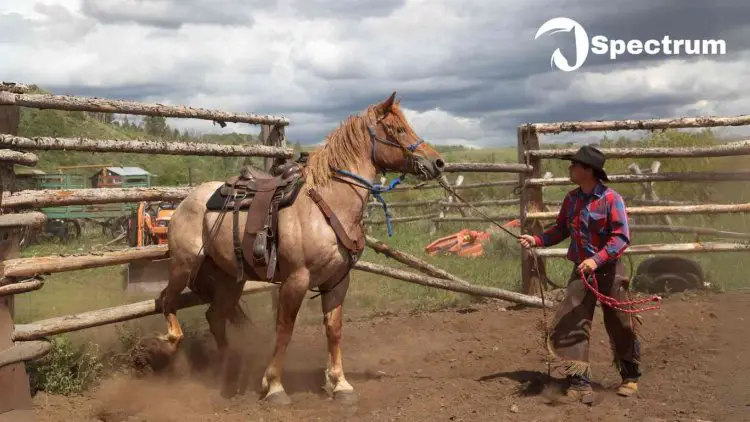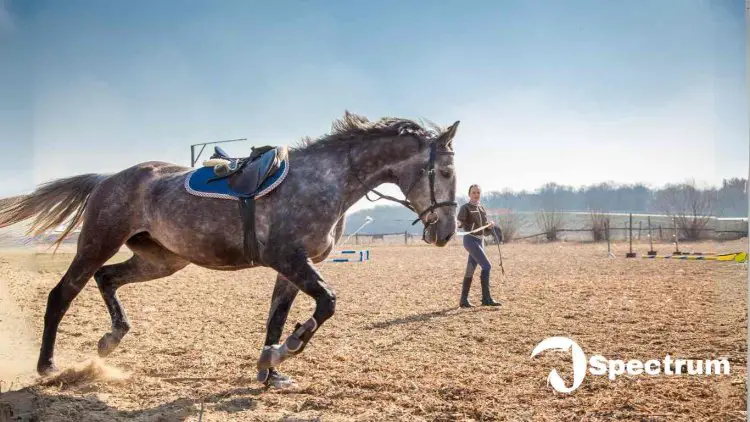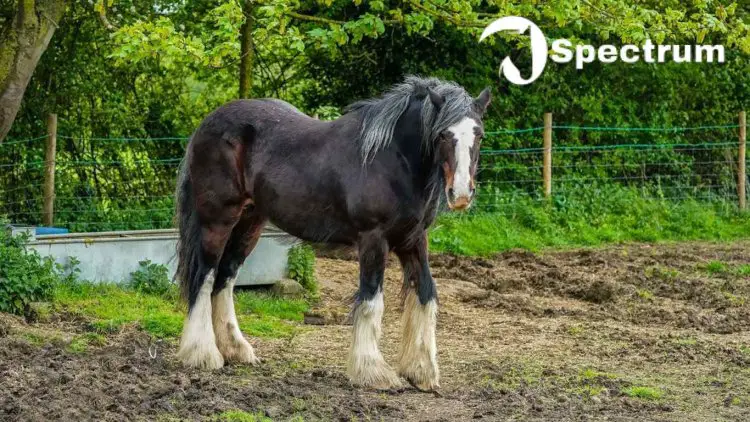Taming Wild Horses: Can a Wild Horse be Domesticated?
Discover the process of domesticating wild horses in our post "Taming Wild Horses: Can a Wild Horse be Domesticated?" Find out if it is feasible to tame wild horses, what the hurdles are, and how to domesticate a wild horse step by step. Explore the horse taming process, from building trust to horse taming in a safe environment and beyond. Understand the differences between wild horses and domestic horse behavior, as well as if wild horses may be trained to flourish as domesticated friends. In addition, we'll go into the laws and ethics of taming wild horses, so you know what you're getting into. If you want to learn more about wild horse domestication, this page will answer all of your questions.

Table of Contents
Introduction
The quintessential image of a wild horse, or mustang, free within its natural habitat, untouched by human interference and untamed resonates deeply within many of us. Yet, there emerges a question in a world where so many animals are tamed or domesticated, can a truly wild horse be tamed? In this article, we will provide you with insights into whether wild horses can be domesticated if yes, what are the challenges and steps involved in taming them?
How to Tame/Domesticate a Wild Horse?

The Definition of Horse Domestication
Domestication refers to the process by which humans convert wild animals into domesticated forms for their use. In the case of the horse, the domestic art of horse taming and domestication can be traced back to when horses were first domesticated in Mongolia. Though challenging, equine aficionados argue that wild horses can be tamed.
The Process of Taming a Wild Horse
To tame a wild horse involves a series of steps that should be carefully conducted to ensure the safety of both the horse and the human involved. The horse used for this process should be gradually introduced to human presence and handling in a secure environment. This process often involves a corral, where it is confined yet comfortable.
1. Establish a secure space: Ensure the horse is contained in a spacious, secure, and comfortable corral that has enough room to move around. The environment should not be too stressful for the horse.
2. Approach the horse: Approach the horse slowly and calmly, with no sudden movements or loud noises. Make sure you allow the horse to see you coming and do not approach from behind. When you are close enough, extend a hand towards the horse to let it smell you and get used to your presence.
3. Create trust: Spend time near the horse without attempting to touch or ride it. This helps in building trust between the horse and the person.
4. Gentle touch: Once the horse is comfortable with your presence, gently touch or pet it but avoid its legs, head, and tail. Starting with their sides or back is generally the safest.
5. Familiarize the horse with harness and saddle: Gradually expose the horse to the harness and saddle. Start by allowing the horse to sniff these objects, then gently lay them on the horse’s body. This familiarizes the horse with the feel of a saddle and harness.
6. Lead the horse: The next step is to train the horse to be led. This can be an extensive process as horses can be resistant at first. Use a lead rope attached to the halter and guide the horse around the corral.
7. Train in riding: Teach the horse to carry weight on its back. First, use a saddle before eventually moving on to a human load. Gradual introduction is key to making the horse comfortable.
8. Reinforcement: Reinforce positive behavior by rewarding the horse with treats or gentle petting. Avoid punishing the horse for negative behavior as this could lead to fear or aggression.
9. Train in commands: Teach the horse basic commands such as “Stop”, “Go", "Left" and "Right". This will take time and patience, but as the horse begins to understand your cues, it will start responding more readily.
10. Seek professional help: If at any point you feel unsafe or unable to proceed, consider bringing in a professional horse trainer. Horse taming requires a lot of skill, patience, and experience.
Remember that every horse is unique and responds differently to stimuli, so it might take longer for some horses to get tamed than others. Patience, consistency, and positive reinforcement are key to successfully taming a wild horse.
Related: How to Stop a Horse From Kicking?
Understanding the Challenges of Horse Taming

Horse taming is a challenging process. Wild horses, being unused to human touch or interaction, exhibit behaviors that deem them potentially dangerous. To this day, the Bureau of Land Management manages an adoption program to promote the transition of wild horses into domesticated horses.
1. Building trust: The primary challenge lies in making horses comfortable with humans. Naturally flighty and suspicious, horses rely on a keen sense of sight, hearing, and touch to perceive potential environmental threats. An abrupt or inappropriate human action can easily frighten a horse, prompting it to react defensively – often by kicking or biting.
2. Handling Confinement: Wild horses are also not accustomed to confinement. Living freestyle in the wild, they are startled by restraints and may resist or panic when confined. These instincts prevent them from readily accepting common domesticated settings like stables or paddocks.
3. Dietary Adjustments: Diet and digestion can also prove to be challenging areas. Wild horses graze freely in a variety of vegetation, while domestic horses are fed controlled diets. This sudden change in food type can disrupt their digestive system, often leading to health issues.
4. Understanding the temperament: Taming horses requires an adequate understanding of horse psychology. Horses, like humans, exhibit a broad spectrum of temperaments and behavioral patterns. Understanding a horse's specific traits and quirks can be difficult and requires patience, experience, and a deep affection for the animal.
5. Physical Adaptations: Horse taming also involves teaching them to accept saddles, bridles, and the rider’s weight—triggers that may incite fear and resistance.
Despite these challenges, horse taming can be rewarding. Domesticated horses can develop strong bonds with their handlers, and their unique characteristics can make them fantastic companions. Whether they are used for work, sport, therapy, or simply as pets, the time and effort put into horse taming can pay off.
What is the Difference Between a Domesticated Horse and a Wild Horse?
The Genetic Evidence of Domestication
The main difference between a wild and domestic horse lies in their genetic makeup. Horse bones have been crucial in providing evidence of when and where horse domestication first occurred. Considering breeds, there's no single 'wild' breed. Rather there are various breeds of domestic horses owing to interbreeding over thousands of years.
Notable Characteristics of a Wild Horse
Wild horses are significantly different from their domestic cousins. Besides the differences in their behavior, a truly wild horse like the Przewalski’s horse, the last surviving breed of truly wild horse, is physically different too. They are generally smaller than domesticated horses and have tougher hooves.
| Aspect | Wild Horses | Domestic Horses |
|---|---|---|
| Habitat | Found in natural, often open environments | Typically housed in stables or pastures |
| Behavior | Often exhibit more cautious behavior | Can display a range of temperaments, from calm to spirited |
| Social Structure | Organized in small family groups or bands | May live in herds or individually |
| Diet | Primarily graze on natural vegetation | Fed a balanced diet of hay, grains, and supplements |
| Hoof Condition | Typically more resilient due to natural wear | May require regular trimming and shoeing |
| Reproduction | Reproduce naturally in the wild | Often bred selectively for specific traits |
| Interaction with Humans | Generally, avoid human contact | Can be trained and interact closely with humans |
| Life Expectancy | May have a shorter lifespan in the wild | May live longer due to a controlled environment and care |
Where Can Wild Horses be Found?

The Natural Habitat of the Wild Horse
Wild horses are remarkably adaptable and can be found in numerous environments worldwide. Wild horses occupy diverse habitats from the grasslands of Mongolia where you can see wild Przewalski's horses to the Western United States.
Concentration of Wild Horses Around the World
Wild horse populations vary greatly across the world. The Bureau of Land Management in the US estimates that there are over 95,000 wild horses and burros on lands under their jurisdiction alone. Moreover, there's a significant population of wild horses left in Mongolia too.
Wild Horses and Their Relationship with the Environment
As free-roaming herbivores, wild horses play a significant role in shaping the ecosystems they inhabit by controlling vegetation. However, overpopulation can lead to detrimental impacts on the land, leading to challenges in managing the wild horse population.
| Location | Description |
|---|---|
| Western North America | Home to mustangs and other wild horse populations roaming across various states such as Nevada, Wyoming, and Montana |
| Eastern Europe | Certain regions like the Carpathian Mountains are known for their populations of wild horses, such as the Hutsul breed in Ukraine |
| Australia | Wild horses, known as brumbies, inhabit various regions, including the Australian Alps and the Northern Territory |
| Asia | Mongolia, particularly the Mongolian steppe, is home to the Przewalski's horse, the only truly wild horse species remaining in the world |
| New Zealand | Kaimanawa Ranges and other remote areas are inhabited by herds of wild Kaimanawa horses |
Related: What do Wild Horses Eat?
Is it Possible for a Domesticated Horse to Revert to its Wild State?

Exploring the Concept of Feral Horses
A feral horse is a domesticated animal that has returned to life in the wild. Though they are often confused with true wild horses, feral horses still carry the genetic traits of domestication. Mustangs in the US are a prime example of feral horses.
Evidence of Domestic Horses Returning to the Wild
Domestic horses can and do return to a wild state when abandoned or escaped from captivity. Over time they can form feral herds. Yet, genetically, they remain domesticated animals. One clear example of this phenomenon is the wild horses of the American West. Starting in the 1500s, European settlers brought domesticated horses to the New World. Some of these animals escaped or were intentionally released, and they eventually formed feral populations in parts of North America.
The Implications of Returning Domestic Horses to the Wild
Returned to the wild, domestic horses can pose significant challenges to maintaining ecological balance. Overpopulation can lead to overgrazing, water pool destruction, and conflict with truly wild species. The Mustang, for instance, is native to the US and has adapted to the environment causing significant ecological changes.
Legal Considerations in Taming Wild Horses
It's essential to ensure you're following all legal requirements related to the process. Here are some legal considerations to take into account:
1. Ownership: One of the major and initial concerns is to determine and establish the ownership of the horse. You cannot tame a horse that is protected by law or belongs to somebody else. In the United States, the Bureau of Land Management governs the adoption of wild mustangs and burros.
2. Animal Welfare Legislation: Various jurisdictions have animal protection laws in place. These laws often stipulate that animals must be provided with adequate food, water, shelter, and veterinary care so that they do not be subjected to cruel treatment.
3. Permit or License: In some areas, a permit or license may be required to capture and tame wild horses. For example, in the United States, a permit is required to round up wild mustangs.
4. Ethical and Humane Treatment: The American Wild Horse Campaign stresses the importance of humane treatment of wild horses. It is illegal to harass or harm wild horses in the United States. Penalties for violations can include fines, imprisonment, or both.
5. Transportation: There may be laws or regulations regarding the transportation of wild horses, which can include requirements for specific types of trailers or health certifications.
6. Intent to sell: Many wild horse adoption programs, such as the Bureau of Land Management's Wild Horse and Burro Program in the U.S., have strict rules about who can adopt and how long an adopter must care for a horse before they are permitted to sell it, usually a year.
7. Record Keeping: Adopters may be required to keep and show detailed records on care, medical treatment, and location of the adoptee.
8. Minimum adoption age: There may be laws about the minimum age of horses for adoption. Usually, the young horses or foals should be weaned from their mother.
Remember, laws vary widely by location, so it's essential to do thorough research and consider consulting with a local attorney or animal welfare organization to understand your responsibilities.
What's Your Reaction?

















